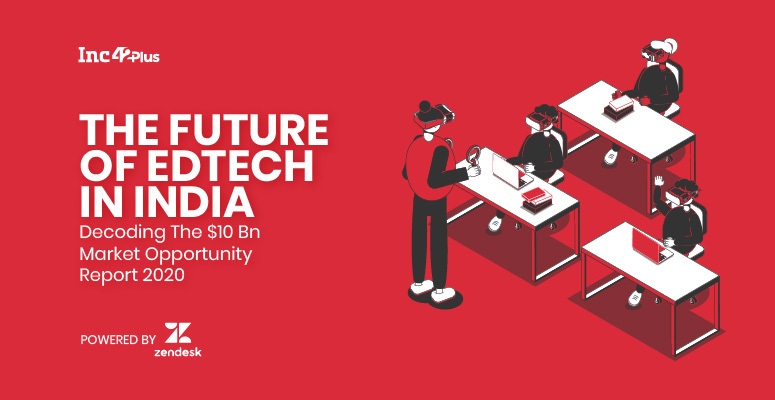The edtech market is estimated to grow 3.7x in the next five years, from $2.8 Bn (2020) to $10.4 Bn (2025)
With growing adoption during the lockdown months, edtech services and products are expected to have an addressable base of 37 Mn-plus paid users by 2025
While edtech was already growing, Covid-19 brought it more momentum, $1.4 Bn invested in the last 9 months. But how long will the bull run last?
Inc42 Daily Brief
Stay Ahead With Daily News & Analysis on India’s Tech & Startup Economy

The pandemic could not have come at a worse time for the Indian education system. For one, not only was the system lagging behind more tech-friendly nations, but it was also not focussed on the one aspect that should be the primary objective — employability of students and not just degrees.
While school education in modern India has become a fundamental right (till the age of 14) thanks to the Right To Education (RTE) added in the 86th constitutional amendment in 2002, the state of higher education is not as robust.
Although the overall state of public education in India is not exactly great, since the inception of RTE, the adult literacy rate in the country has jumped up by 13% from 61% in 2001 to 74% in 2018. At the same time, per capita spending on education in India is around $499 (INR 32,500), which is approximately 4 times lower than the average of upper-middle-income countries.
Moreover, the gap in quality of education delivered in private school and the public institutions is increasing every year, as per the Annual Status of Education Report (ASER), which found that among fifth-grade students only 23% could solve a simple division problem in government schools, while this number was 40% in more expensive private schools.
With the outbreak of Covid-19 in India, though, private and public schools have struggled to facilitate classes with the limited number of online resources available. Naturally, this opened up new frontiers for edtech startups in the Indian market, especially the ones looking at the enterprise or B2B segments.
A deeper analysis of the state of the Indian education market and its technocentric future is found in our latest report — The Future Of Edtech In India: Decoding The $10 Bn Market Opportunity — Powered by Zendesk.
Decoding The $10 Bn Edtech Market Opportunity In India
Taking into account that the pandemic has brought plenty of momentum for edtech adoption in India, the market size of edtech in India is estimated to grow 3.7x in the next five years, from $2.8 Bn (2020) to $10.4 Bn (2025).
Among the edtech sub-sectors, K-12 education startups with $4.3 Bn in total market size will have the single highest market share — 41% of the total edtech market in India.
There can be no argument that the demand for online test preparation solutions is high but the bigger question is how effective these test prep startups are in outcomes and are they the right replacement for the traditional offline coaching.
Besides K-12 education, for kids and younger students, coding is the next frontier as a slew of startups are looking to gain headway in this segment. Edtech startups in the coding and programming segment have come into the limelight post-BYJU’S acquisition of WhiteHat Jr acquisition. Other K-12 players such as Unacedamy, Toppr also brought in coding lessons to capitalise on this wave, and there are early-stage startups such as Tinkerly, Masai School and others that are also targeting this space for various age groups.
The Digital Divide In Online Education
Edtech has always been pegged as a great equaliser which could deliver access to good education in remote areas. However, as the coronavirus lockdown pushes all educational institutions to adopt digital education, equality in education remains a far-fetched idea.
A recent survey of DU students conducted by DU Express showed that 53.8% of 12,214 survey respondents were not able to attend the university’s ongoing online classes. Further, 75.6% of survey respondents said they don’t have a laptop to attend classes or to appear for online exams.
A whopping 79.5% of respondents said they don’t have a broadband connection at their home, and a majority 64.3% of respondents noted that they don’t have stable mobile internet connectivity either.
Edtech startups are looking to capitalise on the opportunity in education enterprises — schools, colleges, coaching institutes and more — and fill these gaps in access to education or provision of online learning classes. As more and more schools go online and rely on virtual classrooms, the adoption of edtech B2B services and products will grow, just as the adoption in enterprise tech tools has grown in the past 6 months.
Find out more about this opportunity and more for India’s edtech startups in our latest release titled— The Future Of Edtech In India: Decoding The $10 Bn Market Opportunity Report, 2020. We have covered both the consumer side and the business side of the Indian edtech market. This includes aspects such as the brand equity score of edtech startups, financial analysis of the top startups, details about the EBITDA-positive startups, the estimated number of paid users by 2025, and emerging new business opportunities along with the relevant market risk.
{{#name}}{{name}}{{/name}}{{^name}}-{{/name}}
{{#description}}{{description}}...{{/description}}{{^description}}-{{/description}}
Note: We at Inc42 take our ethics very seriously. More information about it can be found here.






